Constance Demby,
When Classicism
Becomes Visual Music
By: Ariadna Martín.
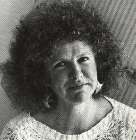 Constance Demby
has in some occasions been defined as the initiator of meditative
music, an internationally famous innovative artist of sonic
creativity, and an original renovator of musical instruments who
shows her undeniable creativity in this field. A fifth-generation
Californian, Constance was born in Oakland, where at age eight she would begin
her musical studies specializing in the piano. Later she moved to
the Eastern coast, at the same time deciding to expand her
studies to the field of painting and sculpture. This versatile
artist and composer, also plays other instruments besides the
piano, like for instance the Chinese cheng, the Persian dulcimer,
the Indian tamboura, the Balinese gamelan, the Austrian harpalek,
plus any other ethnic instrument from any other cultures all over
the world she can lay hands on, always in a most un-traditional
way which turns out to be highly innovative.
Constance Demby
has in some occasions been defined as the initiator of meditative
music, an internationally famous innovative artist of sonic
creativity, and an original renovator of musical instruments who
shows her undeniable creativity in this field. A fifth-generation
Californian, Constance was born in Oakland, where at age eight she would begin
her musical studies specializing in the piano. Later she moved to
the Eastern coast, at the same time deciding to expand her
studies to the field of painting and sculpture. This versatile
artist and composer, also plays other instruments besides the
piano, like for instance the Chinese cheng, the Persian dulcimer,
the Indian tamboura, the Balinese gamelan, the Austrian harpalek,
plus any other ethnic instrument from any other cultures all over
the world she can lay hands on, always in a most un-traditional
way which turns out to be highly innovative.
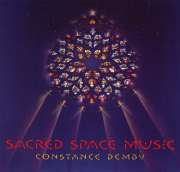 Demby started to engage in the formal meditative arts in the
sixties, an experience she would then use to develop new ways to
express a style of space music in contemporary musical terms
having a definite touch of the classic. Actually, this is how she
explains her peculiar musical style, a style she literally refers
to as "space symphonic classical contemporary
music". During the seventies, Constance Demby gives several live concerts, and also participates in
different workshops as well as multimedia presentations along the
eastern American coast, together with the band Central
Maine Power and Light Company. By the late seventies she
creates her own label, most specifically in 1978, called Sound
Currents, where her first albums of meditative space
music are released: Skies Above Skies in 1978, and Sunborne
in 1980. In this year Demby starts her electronic musical experiments. As she gets
access to digital keyboards and samplers, her studio becomes a
hundred per cent electronic. Constance also
releases a new recording under her own label, Sacred Space
Music in 1982, an album where the composer combines with
unsurpassed mastery the piano, dulcimer and synthesizer, thus
creating one of the first classical compositions whose brilliant
performance place it amongst the pioneering works to be
classified under the generic label New Age. In
this recording Demby prompts the listeners to explore their inner selves,
their spiritual nature, in an introspective exploration of their
souls: "You must temporarily suppress the
control of your ego, let the music lead you to territories that
are perhaps new and unexplored so far", the
artist comments, with respect to this album. This recording would
be followed by Live At Alaron and the compilation album Light
of This World, this one including the best pieces composed
by the artist during this period.
Demby started to engage in the formal meditative arts in the
sixties, an experience she would then use to develop new ways to
express a style of space music in contemporary musical terms
having a definite touch of the classic. Actually, this is how she
explains her peculiar musical style, a style she literally refers
to as "space symphonic classical contemporary
music". During the seventies, Constance Demby gives several live concerts, and also participates in
different workshops as well as multimedia presentations along the
eastern American coast, together with the band Central
Maine Power and Light Company. By the late seventies she
creates her own label, most specifically in 1978, called Sound
Currents, where her first albums of meditative space
music are released: Skies Above Skies in 1978, and Sunborne
in 1980. In this year Demby starts her electronic musical experiments. As she gets
access to digital keyboards and samplers, her studio becomes a
hundred per cent electronic. Constance also
releases a new recording under her own label, Sacred Space
Music in 1982, an album where the composer combines with
unsurpassed mastery the piano, dulcimer and synthesizer, thus
creating one of the first classical compositions whose brilliant
performance place it amongst the pioneering works to be
classified under the generic label New Age. In
this recording Demby prompts the listeners to explore their inner selves,
their spiritual nature, in an introspective exploration of their
souls: "You must temporarily suppress the
control of your ego, let the music lead you to territories that
are perhaps new and unexplored so far", the
artist comments, with respect to this album. This recording would
be followed by Live At Alaron and the compilation album Light
of This World, this one including the best pieces composed
by the artist during this period.
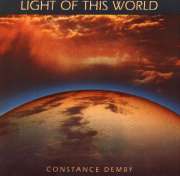 Some time later Constance contacts the label Hearts of Space,
belonging to producer Stephen Hill, and it would
be under this label that this wondrous composer would release her
best masterpieces. In 1986 Hearts of Space
releases her wonderfully glorious Novus
Magnificat, a recording that
reaches the top lists of countless radio stations, a key work of
art for the lovers of space music, where the synthesizers, the
percussion, the organs, the different string instruments, plus an
etheral choir of more than human voices are intertwined with the
particular electronic effects by Michael
Stearns, all this resulting
into a symphony that some critics have compared to Mozart's
Requiem, in a New Age style, a piece of
art that definitely appeals to the highest spiritual potential of
the human being, and whose positive effects are praised by
doctors and nurses in clinics and hospitals given its healing
powers on their patients. Constance
Demby herself explains that this
work is some sort of a "Magnificat" and an
"Exultate" of a contemporary nature for digital
orchestra and choir, where the artist creates an inspired fusion
of Western traditional sacred music with classical influences in
an electronic atmosphere of a contemporary character based on the
timeless archetypes of a musical journey having a deeply
transcendental nature aimed at transforming the listener from
within. This music, composed and performed by the artist using an
Emulator II synthesizer, where the real
symphonic instruments are digitalized by means of samplers on
magnetic disks, later being re-combined and orchestrated by the
author herself, was directly created on the same synthesizer, in
a masterful combination of violas, violins, celli, bassoon, harp,
piano, organ, French horn, bells, electronic effects, tympani and
chorus. All that woven into a whole with the added sound of a Roland
Juno 60, plus a Yamaha grand piano.
Both the general public and the critics have acclaimed this
magnificient creation, which also meant for Demby a noteworthy commercial success.
Some time later Constance contacts the label Hearts of Space,
belonging to producer Stephen Hill, and it would
be under this label that this wondrous composer would release her
best masterpieces. In 1986 Hearts of Space
releases her wonderfully glorious Novus
Magnificat, a recording that
reaches the top lists of countless radio stations, a key work of
art for the lovers of space music, where the synthesizers, the
percussion, the organs, the different string instruments, plus an
etheral choir of more than human voices are intertwined with the
particular electronic effects by Michael
Stearns, all this resulting
into a symphony that some critics have compared to Mozart's
Requiem, in a New Age style, a piece of
art that definitely appeals to the highest spiritual potential of
the human being, and whose positive effects are praised by
doctors and nurses in clinics and hospitals given its healing
powers on their patients. Constance
Demby herself explains that this
work is some sort of a "Magnificat" and an
"Exultate" of a contemporary nature for digital
orchestra and choir, where the artist creates an inspired fusion
of Western traditional sacred music with classical influences in
an electronic atmosphere of a contemporary character based on the
timeless archetypes of a musical journey having a deeply
transcendental nature aimed at transforming the listener from
within. This music, composed and performed by the artist using an
Emulator II synthesizer, where the real
symphonic instruments are digitalized by means of samplers on
magnetic disks, later being re-combined and orchestrated by the
author herself, was directly created on the same synthesizer, in
a masterful combination of violas, violins, celli, bassoon, harp,
piano, organ, French horn, bells, electronic effects, tympani and
chorus. All that woven into a whole with the added sound of a Roland
Juno 60, plus a Yamaha grand piano.
Both the general public and the critics have acclaimed this
magnificient creation, which also meant for Demby a noteworthy commercial success.
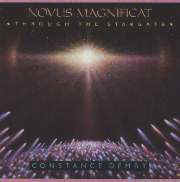 Also under the label Hearts Of Space, Constance Demby releases her album Set Free (1989), where the
influences of other musics such as the Balinese and African
sounds are likewise perceived, a trait that points out the
universal character that pervades Demby's works. In
fact, the author never ceases to experiment with different
acoustic instruments of an ethnic character from all over the
world, adapting them to the digital electronic environment, in an
unquenchable thirst for discovering new sounds that lead to a
musical universality of a classical-contemporary nature. Soon
after, the composer begins her international tours, at the time
visiting several European countries, among them Spain (Canary
Islands), besides Egypt, South America, Japan, Indonesia, and
others.
Also under the label Hearts Of Space, Constance Demby releases her album Set Free (1989), where the
influences of other musics such as the Balinese and African
sounds are likewise perceived, a trait that points out the
universal character that pervades Demby's works. In
fact, the author never ceases to experiment with different
acoustic instruments of an ethnic character from all over the
world, adapting them to the digital electronic environment, in an
unquenchable thirst for discovering new sounds that lead to a
musical universality of a classical-contemporary nature. Soon
after, the composer begins her international tours, at the time
visiting several European countries, among them Spain (Canary
Islands), besides Egypt, South America, Japan, Indonesia, and
others.
Constance Demby cringes over the term New Age due to
the negative stigma that's been attached to it over the years. It
seems anyone that manages to turn out an album using electronic
symphonics falls under the label New Age, no
matter their level of expertise or if they truly are contributing
to expansive, meditative musical style. The use of the New
Age bin as an eclectic dumping ground where the listener
finds more "bad" than "good," has caused a
gradual reduction in sales over the years. Couple this problem
with the negative connotations various religions place on the
term New Age by connecting it with Paganism and
other cult practices, and you have a real stew. It is because of
this that Constance and many other truly professional and highly versed
musicians that have been "stuck" with the New
Age label would love to see this title changed. Which
presents an even greater challenge: What to call it? The problem
is, at a commercial level, there is a great confusion about how
to classify these kinds of musics; those who are in charge of
marketing, or even the shop assistants, keep trying to assign
them a defined categorization, yet they are not sure whether they
should call these musics classical, contemporary, new musics, New
Age, alternative musics...
In her quest to find new
sonic qualities and sounds never heard before, Constance Demby has mastered the art of tuning each emotion to its
complementary tonal resonance, thus provoking different,
impressive experiences on the part of the listener and awakening
in them a sort of emotional catharsis that reaches deep within
the innermost recesses of the very soul, causing an awareness of
conscience in the harmonization of the mind, the body and the
spirit. This particular aspect of her art has led her to develop,
already in the seventies, the most innovative creativity in the
field of sound, since it was then when this artist conceived and
constructed the first Sonic Stainless Steel
instruments to ever exist: The "Space Bass" and the
"Whale Sail". In both cases we basically have enormous
sheets made of stainless steel that are played with bows, and
that generate deep sounds whose primordial resonance has never
been achieved in other, more conventional instruments. The
"Space Bass" consists in a horizontal sheet of
stainless steel measuring about ten feet, with an attachment of
five octaves of rods that are fixed to a bar. These rods are then
played either hitting them in a percussive style, or by means of
a bow, as if it were a violin, or a cello. It appears that the
sound waves generated by the lower notes in this peculiar
instrument can reach a longitude of up to thirty feet. On the
other hand, the "Whale Sail" is in fact some sort of a
cetacean sister version of the "Space Bass", this time
consisting in a vertical sheet of eight feet, interwoven with a
number of wires that are likewise played with a bow. The sonic
quality thus achieved with such peculiar instruments has a
strange touch of the unearthly, hinting at an undescribable
emotional potential.
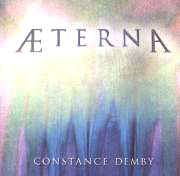 In 1995, Constance
Demby releases Aeterna, a work inspired in classical composers of the romantic
school, namely Rachmaninoff and Tchaikovsky.
In this work, the author takes her music far beyond the earthly
landscapes. The melodic atmosphere that pervades the works of
these two Russian master musicians combines with the sublime
virtuosity typical of a Bach, in a harmony where
the piano becomes the king of all instruments par excellence,
thus resulting into a composition of a highly spiritual
character, passionate, deep, whose beauty surpasses all
descriptions. It looks as if Demby recreated
herself in the sculpting of sounds, thus giving birth to a sonic
landscape which is to become a classic whose power transforms the
listener, expanding the mind, opening the heart to what is to
become the classical music of the twenty-first century in its
most exquisite symphonic quality. A dreamworld music, portraying
feelings from outer space, delightfully adequate to be used in
some planetarium, or maybe as the soundtrack for a movie about
the space lanes, this music takes us to a deeply emotional and
spiritual experience of a transcendental, sublime nature.
In 1995, Constance
Demby releases Aeterna, a work inspired in classical composers of the romantic
school, namely Rachmaninoff and Tchaikovsky.
In this work, the author takes her music far beyond the earthly
landscapes. The melodic atmosphere that pervades the works of
these two Russian master musicians combines with the sublime
virtuosity typical of a Bach, in a harmony where
the piano becomes the king of all instruments par excellence,
thus resulting into a composition of a highly spiritual
character, passionate, deep, whose beauty surpasses all
descriptions. It looks as if Demby recreated
herself in the sculpting of sounds, thus giving birth to a sonic
landscape which is to become a classic whose power transforms the
listener, expanding the mind, opening the heart to what is to
become the classical music of the twenty-first century in its
most exquisite symphonic quality. A dreamworld music, portraying
feelings from outer space, delightfully adequate to be used in
some planetarium, or maybe as the soundtrack for a movie about
the space lanes, this music takes us to a deeply emotional and
spiritual experience of a transcendental, sublime nature.
Nowadays Constance Demby continues to create new sonic worlds of a contemporary
orchestral character in her studio. To do this she utilizes the
latest in electronics technology, including digital samplers and
synthesizers. The composer never ceases to work, so that she can
succeed in achieving the complete mastery of the instruments she
uses, computer controlled, of course, a world that nonetheless
she finds rather arid as well as challenging. To her, it is
somewhat frustrating to find she cannot perform her music just
because she forgot to press some key. This is why she perseveres
in achieving a thorough control of these new technologies. On the
other hand, she plans to continue engaging herself on live world
tours as she already did before. Constance is a
great believer in the power of music to transform the people, as
well as its capacity to awaken the consciousness of the human
being taking it to its most elevated heights. She herself claims
that music is the highest of the arts, it helps us to connect
ourselves with the spirit by means of sound, thus leading us to
our highest faculties, ascending through music to a greater
perspective of the universe surrounding us, of our inner self, of
our spiritual essence. Her music can certainly have a
therapeutical quality, given its relaxing, fluid nature, with a
fresh, expressive, irresistible air that shapes sonic figures in
a classical atmosphere that in her hands become sonic sculptures,
in a word, giving us a present of a classicism that, should we
close our eyes, becomes visual music within our perception,
within our minds.
 Previous Page
(Articles/News)
Previous Page
(Articles/News)
 Constance Demby
has in some occasions been defined as the initiator of meditative
music, an internationally famous innovative artist of sonic
creativity, and an original renovator of musical instruments who
shows her undeniable creativity in this field. A fifth-generation
Californian, Constance was born in Oakland, where at age eight she would begin
her musical studies specializing in the piano. Later she moved to
the Eastern coast, at the same time deciding to expand her
studies to the field of painting and sculpture. This versatile
artist and composer, also plays other instruments besides the
piano, like for instance the Chinese cheng, the Persian dulcimer,
the Indian tamboura, the Balinese gamelan, the Austrian harpalek,
plus any other ethnic instrument from any other cultures all over
the world she can lay hands on, always in a most un-traditional
way which turns out to be highly innovative.
Constance Demby
has in some occasions been defined as the initiator of meditative
music, an internationally famous innovative artist of sonic
creativity, and an original renovator of musical instruments who
shows her undeniable creativity in this field. A fifth-generation
Californian, Constance was born in Oakland, where at age eight she would begin
her musical studies specializing in the piano. Later she moved to
the Eastern coast, at the same time deciding to expand her
studies to the field of painting and sculpture. This versatile
artist and composer, also plays other instruments besides the
piano, like for instance the Chinese cheng, the Persian dulcimer,
the Indian tamboura, the Balinese gamelan, the Austrian harpalek,
plus any other ethnic instrument from any other cultures all over
the world she can lay hands on, always in a most un-traditional
way which turns out to be highly innovative. Demby started to engage in the formal meditative arts in the
sixties, an experience she would then use to develop new ways to
express a style of space music in contemporary musical terms
having a definite touch of the classic. Actually, this is how she
explains her peculiar musical style, a style she literally refers
to as "space symphonic classical contemporary
music". During the seventies, Constance Demby gives several live concerts, and also participates in
different workshops as well as multimedia presentations along the
eastern American coast, together with the band Central
Maine Power and Light Company. By the late seventies she
creates her own label, most specifically in 1978, called Sound
Currents, where her first albums of meditative space
music are released: Skies Above Skies in 1978, and Sunborne
in 1980. In this year Demby starts her electronic musical experiments. As she gets
access to digital keyboards and samplers, her studio becomes a
hundred per cent electronic. Constance also
releases a new recording under her own label, Sacred Space
Music in 1982, an album where the composer combines with
unsurpassed mastery the piano, dulcimer and synthesizer, thus
creating one of the first classical compositions whose brilliant
performance place it amongst the pioneering works to be
classified under the generic label New Age. In
this recording Demby prompts the listeners to explore their inner selves,
their spiritual nature, in an introspective exploration of their
souls: "You must temporarily suppress the
control of your ego, let the music lead you to territories that
are perhaps new and unexplored so far", the
artist comments, with respect to this album. This recording would
be followed by Live At Alaron and the compilation album Light
of This World, this one including the best pieces composed
by the artist during this period.
Demby started to engage in the formal meditative arts in the
sixties, an experience she would then use to develop new ways to
express a style of space music in contemporary musical terms
having a definite touch of the classic. Actually, this is how she
explains her peculiar musical style, a style she literally refers
to as "space symphonic classical contemporary
music". During the seventies, Constance Demby gives several live concerts, and also participates in
different workshops as well as multimedia presentations along the
eastern American coast, together with the band Central
Maine Power and Light Company. By the late seventies she
creates her own label, most specifically in 1978, called Sound
Currents, where her first albums of meditative space
music are released: Skies Above Skies in 1978, and Sunborne
in 1980. In this year Demby starts her electronic musical experiments. As she gets
access to digital keyboards and samplers, her studio becomes a
hundred per cent electronic. Constance also
releases a new recording under her own label, Sacred Space
Music in 1982, an album where the composer combines with
unsurpassed mastery the piano, dulcimer and synthesizer, thus
creating one of the first classical compositions whose brilliant
performance place it amongst the pioneering works to be
classified under the generic label New Age. In
this recording Demby prompts the listeners to explore their inner selves,
their spiritual nature, in an introspective exploration of their
souls: "You must temporarily suppress the
control of your ego, let the music lead you to territories that
are perhaps new and unexplored so far", the
artist comments, with respect to this album. This recording would
be followed by Live At Alaron and the compilation album Light
of This World, this one including the best pieces composed
by the artist during this period. Some time later Constance contacts the label Hearts of Space,
belonging to producer Stephen Hill, and it would
be under this label that this wondrous composer would release her
best masterpieces. In 1986 Hearts of Space
releases her wonderfully glorious
Some time later Constance contacts the label Hearts of Space,
belonging to producer Stephen Hill, and it would
be under this label that this wondrous composer would release her
best masterpieces. In 1986 Hearts of Space
releases her wonderfully glorious 
